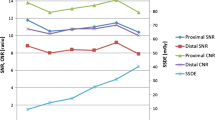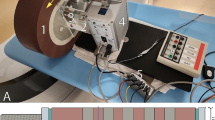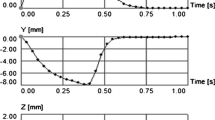Abstract
Purpose
The authors sought to compare different algorithms for dose reduction in retrospectively echocardiographically (ECG)-gated dual-source computed tomography (CT) coronary angiography (DSCT-CA) in a phantom model.
Materials and methods
Weighted CT dose index (CTDI) was measured by using an anthropomorphic phantom in spiral cardiac mode (retrospective ECG gating) at five pitch values adapted with two heart-rate-adaptive ECG pulsing windows using four algorithms: narrow pulsing window, with tube current reduction to 20% (A) and 4% (B) of peak current outside the pulsing window; wide pulsing window, with tube current reduction to 20% (C) and 4% (D). Each algorithm was applied at different heart rates (45, 60, 75, 90, 120 bpm).
Results
Mean CTDI volume (CTDIvol) was 36.9±9.7 mGy, 23.9±5.6 mGy, 49.7±16.2 mGy and 38.5±12.3 mGy for A, B, C and D, respectively. Consistent dose reduction was observed with protocols applying the 4% tube current reduction (B and D). Using the conversion coefficient for the chest, the mean effective dose was the highest for C (9.6 mSv) and the lowest for B (4.6 mSv). Heart-ratedependent pitch values (pitch=0.2, 0.26, 0.34, 0.43, 0.5) and the use of heart-rate-adaptive ECG pulsing windows provided a significant decrease in the CTDIvol with progressively higher heart rates (45, 60, 75, 90, 120 bpm), despite using wider pulsing windows.
Conclusions
Radiation exposure with DSCT-CA using a narrow pulsing window significantly decreases when compared with a wider pulsing window. When using a protocol with reduced tube current to 4%, the radiation dose is significantly lower.
Riassunto
Obiettivi
Lo scopo di questo studio è valutare mediante un fantoccio gli algoritmi di riduzione della dose in angiografia coronarica con tomografia computerizzata a doppia sorgente (DSCT-CA) con modalità di scansione spirale.
Materiali e metodi
Sono stati valutati 4 protocolli electrocardiographic (ECG)-gated retrospettivo DSCT-CA delle arterie coronarie, acquisiti con pitch ECG adattativo e modulazione ECG prospettica della corrente del tubo. Nei protocolli A e B è stata utilizzata una finestra di pulsing stretta (narrow), con riduzione della corrente del tubo al 20% (A) e al 4% (B) del valore nominale della corrente, al di fuori della finestra di pulsing; nei protocolli C e D è stata utilizzata una finestra di pulsing ampia (wide), con riduzione della corrente del tubo al 20% (C) e al 4% (D) del valore nominale della corrente, al di fuori della finestra di pulsing.
Risultati
Il valore medio del computed tomography dose index volume (CTDIvol) è risultato 36,9±9,7 mGy e 23,9±5,6 mGy nei protocolli A e B, rispettivamente (r=0,97; p<0,005); 49,7±16,19 mGy e 38,5±12,25 mGy nei protocolli C e D, rispettivamente (r=1,0; p<0,005). Una consistente riduzione di dose è stata osservata con i protocolli di modulazione della corrente al 4% (B e D). Utilizzando il coefficiente di conversione per il torace, il valore medio di dose è stato maggiore nel protocollo C (9,6 mSv) e minore nel protocollo B (4,6 mSv). L’utilizzo del pitch ECG adattativo (pitch=0,2-0,26-0,34-0,43-0,5) e gli algoritmi di pulsing con finestra stretta forniscono una consistente riduzione della dose (vale a dire >60%) all’aumentare della frequenza cardiaca.
Conclusioni
In DSCT-CA, l’utilizzo di una finestra di pulsing stretta riduce significativamente la dose da radiazioni, se comparata ad una finestra di pulsing più ampia. Con l’utilizzo di un protocollo con modulazione della corrente al 4%, la dose di radiazione è significativamente minore.
Similar content being viewed by others
References/Bibliografia
Fei X, Du X, Li P et al (2008) Effect of dose-reduced scan protocols on cardiac coronary image quality with 64-row MDCT: a cardiac phantom study. Eur J Radiol 67:85–91
Romagnoli A, Nisini A, Gandini R et al (2002) Multidetector row CT coronary angiography: technique and preliminary experience. Radiol Med 103:443–455
Passariello R, De Santis M (2001) Coronary artery desease. Update and prospects of radiologic imaging with CT and MR. Radiol Med 101:411–423
Luz O, Buchgeister M, Klabunde M et al (2007) Evaluation of dose exposure in 64-slice CT colonography. Eur Radiol 17:2616–2621
Schoepf UJ, Becker CR, Ohnesorge BM et al (2004) CT of coronary artery disease. Radiology 232:18–37
Cademartiri F, Luccichenti G, Marano R et al (2003) Non-invasive angiography of the coronary arteries with multislice computed tomography: state of the art and future prospect. Radiol Med 106:284–296
Kopp AF, Schroeder S, Kuettner A et al (2001) Coronary arteries: retrospectively ECG-gated multi-detector row CT angiography with selective optimization of the image reconstruction window. Radiology 221:683–688
Gerber TC, Stratmann BP, Kuzo RS et al (2005) Effect of acquisition technique on radiation dose and image quality in multidetector row computed tomography coronary angiography with submillimeter collimation. Invest Radiol 40:556–563
Vogl TJ, Abolmaali ND, Diebold T et al (2002) Techniques for the detection of coronary artherosclerosis: multi-detector row CT coronary angiography. Radiology 223:212–220
Giesler T, Baum U, Ropers D et al (2002) Non invasive visualization of coronary artery using contrastenhanced multidetector CT: influence of heart rate on image quality and stenosis detection. AJR Am J Roentgenol 179:911–916
Li ZL, Guo YK, Hu G et al (2008) Influence of cardiac rhythm on image quality of 64-slice multidetector-row CT coronary angiography and clinic value of post-processing technology with image. Sichuan Da Xue Xue Bao Yi Xue Ban 39:305–308
Herzog C, Arning-Erb M, Zangos S et al (2006) Multi-detector row CT coronary angiography: influence of reconstruction technique and heart rate on image quality. Radiology 238:75–86
McCollough C, Primak A, Saba O et al (2007) Dose performance of a 64-channel dual-source CT scanner. Radiology 243: 775–784
Primak AN, McCollough CH, Bruesewitz MR et al (2006) Relationship between noise, dose, and pitch in cardiac multi-detector row CT. RadioGraphics 26:1785–1794
Francone M, Napoli A, Carbone I et al (2007) Noninvasive imaging of the coronary arteries using a 64-row multidetector CT scanner: initial clinical experience and radiation dose concerns. Radiol Med 112:31–46
Nagatani Y, Takahashi M, Takazakura R et al (2007) Multidetector-row computed tomography coronary angiography: optimization of image reconstruction phase according to the heart rate. Circ J 71:112–121
Flohr TG, McCollough CH, Bruder H et al (2006) First performance evaluation of a dual-source CT (DSCT) system. Eur Radiol 16:256–268
Johnson TR, Nikolaou K, Wintersperger BJ et al (2006) Dual source CT cardiac imaging: initial experience. Eur Radiol 16:1409–1415
Scheffel H, Alkadhi H, Plass A et al (2006) Accuracy of dual-source CT coronary angiography: first experience in a high pre-test probability population without heart rate control. Eur Radiol 16:2739–2747
Stolzmann P, Scheffel H, Schertler T et al (2007) Radiation dose estimates in dual-source computed tomography coronary angiography. Eur Radiol 18:592–599. DOI 10.1007/s00330-007-0786-8
Ropers U, Ropers D, Pflederer T et al (2007) Influence of heart rate on the diagnostic accuracy of dual-source computed tomography coronary angiography. J Am Coll Cardiol 50:2393–2398
Leschka S, Scheffel H, Desbiolles L et al (2007) Image quality and reconstruction intervals of dual-source CT coronary angiography: recommendations for ECG-pulsing windowing. Invest Radiol 42:543–549
Weustink AC, Mollet NR, Pugliese F et al (2008) Optimal electrocardiographic pulsing windows and heart rate: effect on image quality and radiation exposure at dual-source coronary CT angiography. Radiology 248:792–798
Garcia MJ (2006) Clinical experience and progress of computed tomographic coronary angiography. Coron Artery Dis 17:99–105
Kuettner A, Beck T, Drosch T et al (2005) Image quality and diagnostic accuracy of non-invasive coronary imaging with 16 detector slice spiral computed tomography with 188 ms temporal resolution. Heart 91:938–941
Siriapisith T, Wasinrat J (2008) Comparison of image quality of coronary CT angiography between 16 and 64 slices MDCT. J Med Assoc Thai 91:364–371
Kopp AF, Heuschmid M, Reimann A et al (2005) Advances in imaging protocols for cardiac MDCT: from 16- to 64-row multidetector computed tomography. Eur Radiol 15 [Suppl 5]:E71–E77
Flohr TG, Stierstorfer K, Ulzheimer S et al (2005) Image reconstruction and image quality evaluation for a 64-slice CT scanner with z-flying focal spot. Med Phys 32:2536–2547
Hirai N, Horiguchi J, Fujioka C et al (2008) Prospective versus retrospective ECG-gated 64-detector coronary CT angiography: assessment of image quality, stenosis, and radiation dose. Radiology 248:424–430
Author information
Authors and Affiliations
Corresponding author
Rights and permissions
About this article
Cite this article
Martini, C., Palumbo, A., Maffei, E. et al. Dose reduction in spiral CT coronary angiography with dual-source equipment. Part I. A phantom study applying different prospective tube current modulation algorithms. Radiol med 114, 1037–1052 (2009). https://doi.org/10.1007/s11547-009-0437-z
Received:
Accepted:
Published:
Issue Date:
DOI: https://doi.org/10.1007/s11547-009-0437-z




